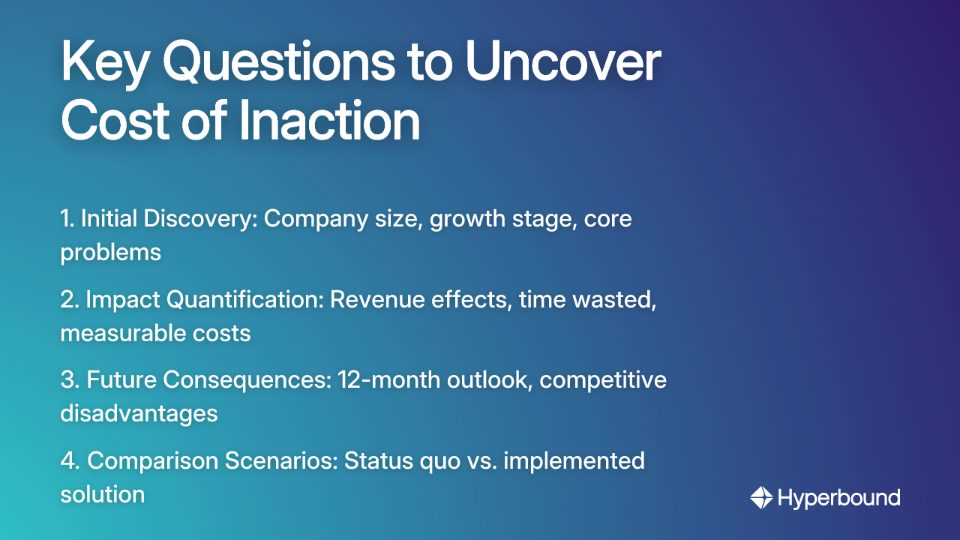
You've been working tirelessly on a promising enterprise deal for months. The prospect seems interested, your solution perfectly addresses their needs, and yet... nothing happens. The deal stalls in that dreaded "decision pending" limbo. Sound familiar?
If you're struggling to close big deals because you "cannot figure out how to create urgency," you're facing what might be the biggest challenge in modern sales. And it's not what you think.
The Silent Deal-Killer: Customer Indecision

According to research by Matthew Dixon and Ted McKenna published in Harvard Business Review, over 40-60% of deals are lost to customer indecision, not to competitors. That's right - your biggest competitor isn't the other vendor; it's the status quo.
As one sales professional put it: "In most cases, the sense of urgency is not there because you are replacing a solution that, although not as good as yours, does work 'good enough' to keep things going."
This is where understanding and leveraging the "Cost of Inaction" (COI) becomes your secret weapon.
What is the 'Cost of Inaction'?
The Cost of Inaction is the tangible and intangible price a business pays by maintaining the status quo - by not making a change or decision. It encompasses:
- Financial losses (direct and indirect)
- Wasted time and resources
- Missed opportunities
- Increased risk exposure
- Competitive disadvantage
While most salespeople focus on ROI (Return on Investment) to showcase what prospects gain by using their solution, the COI flips the script and reveals what prospects lose by doing nothing.
It answers critical questions that create natural urgency:
- What happens if you do nothing?
- Why now?
- Why not next year?
Why Quantifying Pain is a Sales Superpower
When you help prospects quantify their pain in concrete terms, several powerful things happen:
1. You Create Natural Urgency
When a CFO understands they're losing $25,000 monthly due to inefficient processes, waiting suddenly seems expensive. When a CTO realizes security vulnerabilities expose them to $1.5M in potential breach costs, "someday" becomes "today."
2. You Build an Airtight Business Justification
By quantifying the cost of problems, you give decision makers the ammunition they need to justify the purchase internally. This is especially crucial when dealing with executive decision makers who must defend spending to their boards or leadership teams.
3. You Transform from Vendor to Advisor
The SPIN model teaches us that when you help prospects discover and quantify their own pain points, you position yourself as a trusted advisor rather than a pushy salesperson. This dramatically shifts the power dynamic in your favor.

A Practical Framework for Calculating and Communicating COI
Let's break down how to effectively uncover, calculate, and communicate the Cost of Inaction to create genuine urgency.
Step 1: Uncover the Pain with Strategic Questioning

Begin with targeted qualifying questions to uncover the full scope of your prospect's pain points. The best questions follow a progression:
Initial Discovery Questions:
- "How big is your company today in terms of annual revenue and employee headcount?"
- "Is the business struggling, in a steady state, or in growth mode?"
- "What specific problem are you looking to solve?"
Impact-Quantifying Questions:
- "How does this problem affect your revenue, profitability, or operational efficiency?"
- "How many hours per week does your team spend dealing with this issue?"
- "What's the average cost associated with each occurrence of this problem?"
- "How do you currently measure the impact of [problem] in your organization?"
Future-Pacing & Consequence Questions:
- "If this issue persists, what impact do you foresee in the next 12 months?"
- "What happens if you address the problem? What happens if you don't?"
- "Are your competitors gaining ground because they've already solved this problem?"
Using AI sales roleplay platforms like Hyperbound, reps can practice these questions in realistic scenarios until they become second nature. Remember, the goal is to guide prospects to articulate the pain in their own words, making it more real and urgent to them.
Step 2: Guide Them to Do the Math
Don't present a pre-calculated cost analysis. Instead, collaborate with your prospect to build the calculation together:
- Start simple: "Based on what you've shared, let's try to put some numbers to this issue."
- Use basic formulas they can easily grasp:
- Wasted time:
[Hours wasted per week] × [Number of employees affected] × [Average hourly cost] × 52 weeks = Annual cost of inefficiency - Lost revenue:
[Number of lost opportunities] × [Average deal size] = Revenue impact - Error costs:
[Error frequency] × [Cost per error] × [Time period] = Total error cost
- Wasted time:
- Underestimate rather than exaggerate: "I want to be conservative with these numbers. Would you say losing $10,000 per month is a fair estimate, or is that too high?"
This approach builds credibility and ownership because they're participating in the calculation.
Step 3: Frame the Conversation with Comparative Scenarios
Once you've established the cost, present two clear futures:
Scenario A (Inaction):"Based on our calculation, continuing with the current process means you'll lose approximately $300,000 over the next year, plus face increasing competitive pressure and employee frustration."
Scenario B (Action):"By implementing our solution, you could recapture a significant portion of that $300,000, while positioning your team to handle the upcoming market expansion more effectively."
Then ask the pivotal question: "If we could help you recover even 50% of that $300,000, would that justify moving forward with this project now rather than later?"
COI in Action: Industry Examples
Let's look at how the Cost of Inaction manifests across different industries with concrete examples:
Technology Sector
Simulated cold call scenario: A CRM implementation for a sales team currently using spreadsheets.
Cost of Inaction calculation:
- 200 hours per month in manual data entry across the sales team
- 15% of leads falling through the cracks due to poor follow-up cadence
- Average deal size: $20,000
- Estimated annual cost: $720,000 in wasted time and lost opportunities
Tailored scenario for the executive decision maker: "Your sales team is spending over 25% of their time on administrative tasks rather than selling, while competitors with automated systems are converting leads 40% faster."
Healthcare
Pain point: Inefficient patient data management leading to errors and readmissions.
Cost of Inaction calculation:
- 30 preventable readmissions per month
- Average cost per readmission: $15,000
- Regulatory penalties for high readmission rates: $500,000
- Annual cost: $5.9 million
"Every month of delay costs your hospital nearly $500,000 in preventable expenses, not counting the patient experience impact and reputation damage."
Software / SaaS
Pain point: A sales team's deals are consistently stalling, with win rates suffering against the "do nothing" alternative.
Cost of Inaction analysis with AI:
- Using a platform like Hyperbound's AI Real Call Scoring, a sales leader analyzes call recordings from stalled deals.
- The AI discovers that in over 75% of these calls, reps failed to establish a clear, quantified Cost of Inaction.
- Average deal size: $50,000
- 5 winnable deals stall each month due to lack of urgency.
- Estimated annual cost: $3 million in lost revenue opportunities.
"The data from our calls is clear: we are losing deals because we fail to make the cost of 'doing nothing' tangible for our prospects. This isn't a competitor issue; it's a sales skill gap that's costing us millions."
Best Practices and Pitfalls to Avoid
Do:
- Quantify multiple dimensions of cost: Financial, time, risk, and opportunity costs all contribute to the total COI.
- Use the prospect's language: When they describe their pain points in their own words, it resonates more strongly.
- Connect COI to business goals: Show how inaction undermines their strategic objectives and key performance indicators.
- Maintain ethical standards: The goal is to illuminate real costs, not manufacture false urgency through high-pressure tactics.
Don't:
- Exaggerate the numbers: Credibility is essential; conservative estimates build trust.
- Rush the process: Revealing the COI requires careful discovery and qualification.
- Present a one-size-fits-all calculation: Each prospect's situation is unique.
From Salesperson to Strategic Advisor
Remember that true urgency isn't created through artificial deadlines or pressure tactics. It emerges naturally when prospects fully understand the consequences of maintaining the status quo.
By helping prospects quantify their Cost of Inaction, you transform from a vendor pushing products into a trusted advisor helping them make informed business decisions. This approach not only shortens the sales cycle but builds stronger, more sustainable customer relationships.
The next time you face a stalled deal, don't immediately resort to discounts or artificial deadlines. Instead, revisit your discovery process and help the prospect answer the most critical question in sales: "What happens if you do nothing?"
Because in today's competitive business environment, doing nothing is rarely free—in fact, it's often the most expensive option of all.
Frequently Asked Questions
What is the Cost of Inaction (COI) in sales?
The Cost of Inaction (COI) is the total price a business pays for maintaining its current situation and not making a decision. It goes beyond direct financial losses to include wasted time, missed opportunities, increased risks, and a decline in competitive advantage. By focusing on what a prospect loses by doing nothing, COI creates a natural sense of urgency that is more powerful than focusing solely on the Return on Investment (ROI) of a new solution.
Why is customer indecision a bigger threat than competitors?
Customer indecision is a bigger threat because a significant portion of deals, often between 40-60%, are lost not to a competing vendor but to the customer choosing to do nothing. This "no decision" outcome is often due to the perception that their current solution is "good enough." Your primary challenge is to overcome the inertia of the status quo by clearly demonstrating that inaction is more costly and riskier than making a change.
How can I calculate the Cost of Inaction for a prospect?
To calculate the Cost of Inaction, guide your prospect through a collaborative process of quantifying their pain points. Use simple formulas based on the information they provide, such as [Hours wasted per week] × [Number of employees] × [Average hourly cost] for inefficiency, or [Number of lost opportunities] × [Average deal size] for lost revenue. The key is to co-create the calculation, which builds credibility and helps the prospect internalize the true cost of their problem.
What is the difference between ROI and COI?
The key difference lies in their focus: Return on Investment (ROI) highlights the future gains from purchasing your solution, while the Cost of Inaction (COI) emphasizes the current and future losses from not purchasing it. While ROI is about a positive future, COI is about avoiding a negative one. Effective salespeople use both, first establishing the COI to create urgency and then using ROI to justify the investment.
How do I introduce the Cost of Inaction without sounding pushy?
Introduce the Cost of Inaction by positioning yourself as a strategic advisor, not a pushy salesperson. This is achieved through consultative questioning. Instead of telling them their costs, ask impact-quantifying questions like, "How many hours does your team spend on this weekly?" or "How does this issue affect your revenue goals?" When you guide them to discover and state the costs themselves, the urgency feels authentic and self-realized, not manufactured by you.
When is the best time to discuss the Cost of Inaction?
The best time to discuss the Cost of Inaction is during the discovery and qualification stages of the sales process, after you have established rapport and understood their initial problems. It's not a topic for the first few minutes of a cold call. Introduce it once you have a clear understanding of their business challenges, allowing you to ask targeted questions that help quantify the pain. This quantified pain then becomes the foundation for your business case throughout the rest of the sales cycle.

Book a demo with Hyperbound
.png)













